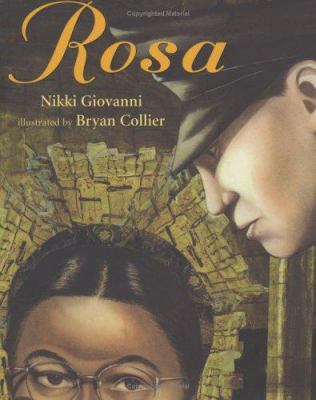
by Nikki Giovanni
Publishers Weekly: Starred Review. Giovanni (The Sun Is So Quiet) and Collier (Uptown) offer a moving interpretation of Rosa Parks's momentous refusal to give up her bus seat. The author brings her heroine very much to life as she convincingly imagines Parks's thoughts and words while she rode the bus on December 1, 1955 ("She was not frightened. She was not going to give in to that which was wrong"), pointing out that Mrs. Parks was in the neutral section of the bus and (as some fellow riders observe) "She had a right to be there." The author and poet lyrically rephrases what the heroine herself has frequently said, "She had not sought this moment, but she was ready for it." After Mrs. Parks's arrest, the narrative's focus shifts to the 25 members of the Women's Political Council, who met secretly to stage the bus boycott. Inventively juxtaposing textures, patterns, geometric shapes and angles, Collier's watercolor and collage art presents a fitting graphic accompaniment to the poetic text. After viewing an image of Martin Luther King, Jr., encouraging a crowd to walk rather than ride the buses, readers open a dramatic double-page foldout of the Montgomery masses walking for nearly a year before the Supreme Court finally ruled that segregation on buses was illegal. A fresh take on a remarkable historic event and on Mrs. Parks's extraordinary integrity and resolve. Ages 5-up. (Sept.) Copyright © Reed Business Information, a division of Reed Elsevier Inc. All rights reserved. Distributed by Syndetic Solutions Inc. Terms
School Library Journal: Gr 3-5–Rosa Parks's personal story moves quickly into a summary of the Civil Rights movement in this striking picture book. Parks is introduced in idealized terms. She cares for her ill mother and is married to one of the best barbers in the county. Sewing in an alterations department, Rosa Parks was the best seamstress. Her needle and thread flew through her hands like the gold spinning from Rumpelstiltskin's loom. Soon the story moves to her famous refusal to give up her seat on the bus, but readers lose sight of her as she waits to be arrested. Giovanni turns to explaining the response of the Women's Political Caucus, which led to the bus boycott in Montgomery. A few events of the movement are interjected–the Supreme Court decision in Brown v. Board of Education, the aftermath and reactions to the murder of Emmett Till, the role of Martin Luther King, Jr., as spokesperson. Collier's watercolor and collage scenes are deeply hued and luminous, incorporating abstract and surreal elements along with the realistic figures. Set on colored pages, these illustrations include an effective double foldout page with the crowd of successful walkers facing a courthouse representing the 1956 Supreme Court verdict against segregation on the buses. Many readers will wonder how it all went for Parks after her arrest, and there are no added notes. Purposeful in its telling, this is a handsome and thought-provoking introduction to these watershed acts of civil disobedience.–Margaret Bush, Simmons College, Boston Copyright © Reed Business Information, a division of Reed Elsevier Inc. All rights reserved. Distributed by Syndetic Solutions Inc. Terms
|

